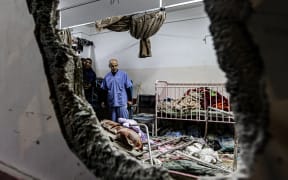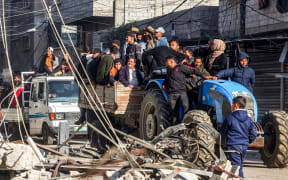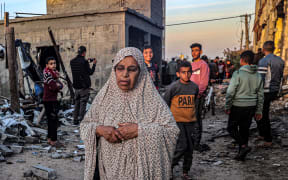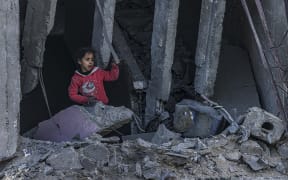By Alys Davies and Paul Adams, diplomatic correspondent
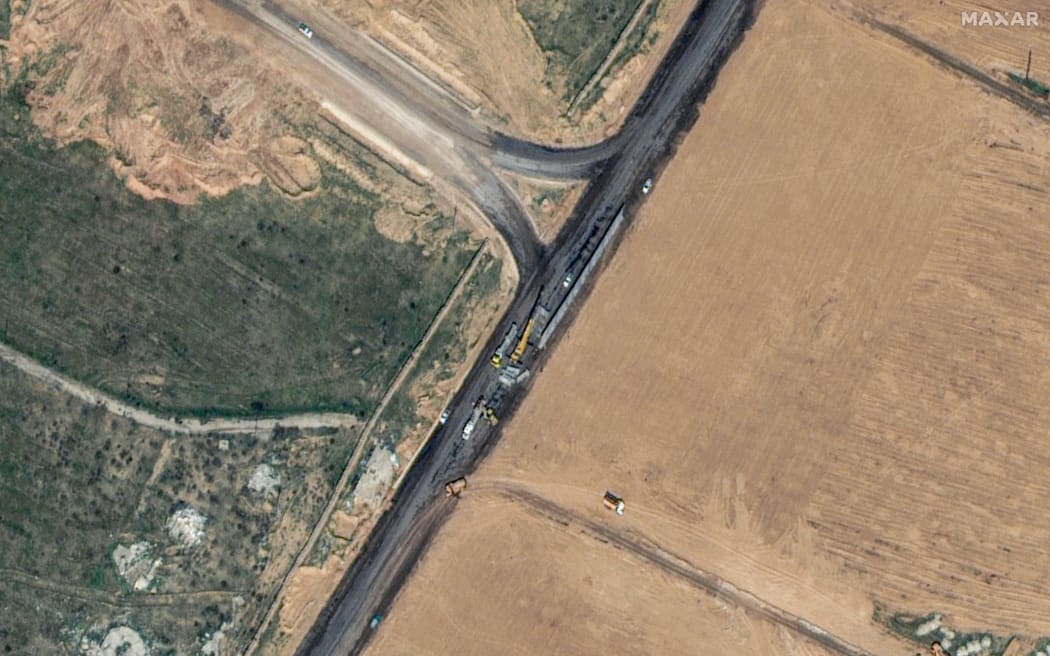
A handout satellite picture taken and released by Maxar Technologies on 15 February, 2024 shows machinery building a wall along the Egypt-Gaza Strip border in Rafah, Egypt. Photo: Handout / Satellite image ©2024 Maxar Technologies / AFP
Satellite images appear to show extensive construction work in progress along Egypt's border with Gaza, which reports claim is being carried out in preparation for housing Palestinian refugees.
Unnamed Egyptian sources reportedly said the work is being done in order to set up an isolated buffer zone containing a walled enclosure in Egypt's North Sinai province in case Israel goes ahead with its planned ground offensive in Gaza's southernmost city, Rafah.
According to a report published by a human rights group, seven-metre-high walls are being constructed in the zone.
Egypt has publicly denied making any such preparations.
Defence Minister Yoav Gallant also said Israel "has no intention of evacuating Palestinian civilians to Egypt".
Since the start of the Gaza war following Hamas's attack on Israel on 7 October, Egypt has consistently said it would not open its border to refugees.
It has taken that stance partly because it does not want to appear complicit in the large-scale displacement of Palestinians, but also out of economic and security concerns.
Israeli Prime Minister Benjamin Netanyahu appears set on a major offensive in Rafah - where some 1.4 million people are sheltering - despite a chorus of international warnings.
Israel claims Hamas forces are in the city and must be "eliminated". It also believes Israeli hostages - of which 130 are still unaccounted for - are being held there.
Ahead of the planned assault on Rafah, Israel is directing civilians to move to open ground north of the city.
Netanyahu has spoken vaguely of "areas that we've cleared north of Rafah", but indications suggest planning is still at an early stage.
Israel had earlier instructed Palestinians to head to Rafah while fighting went on in the north of the strip at the start of its offensive.
"We will fight until complete victory and this includes a powerful action also in Rafah after we allow the civilian population to leave the battle zones," Netanyahu said on Thursday.
The latest satellite imagery, released by Maxar Technologies, may suggest that Egypt has decided to take precautionary measures as a result of the impending offensive.
In one image, dated 15 February, large areas of land close to the Rafah crossing into Gaza appear to have been cleared.
The work appears to have been completed in the last few days, as can be seen when comparing the landscape with an earlier image of the same area from five days ago.
Construction and clearing near Gaza border
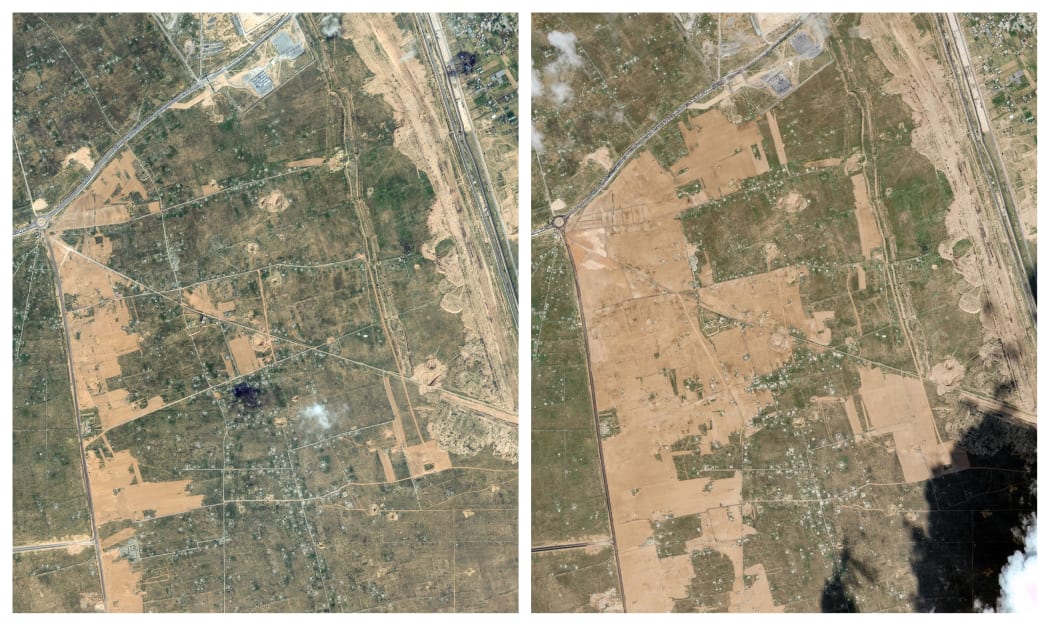
Handout satellite pictures taken on 10 February, 2024 (L) and 15 February, 2024 (R) by Maxar Technologies show an overview of the area adjacent to the Egypt-Gaza Strip border in Rafah, Egypt. The Rafah crossing is seen in the centre at the top of each image. Photo: Handout / Satellite image ©2024 Maxar Technologies / AFP
Speaking to Saudi news network Al Arabiya Al Hadath TV on Thursday, the governor of Egypt's North Sinai province, Mohammed Shousha, said the purpose of the activity in the area was "to conduct an inventory of the houses" destroyed during Egypt's past campaign against the Islamic State group in the area.
Shousha added that Egypt's position is "not to allow the forced displacement of Gaza residents into Egypt".
But satellite imagery from 15 February also shows construction vehicles dotted along the road next to the cleared border area, with some of them appearing to be erecting a large wall.
In the below close up, a vehicle can be seen next to wall panels which appear to be laid on the ground ready to be added to the wall.
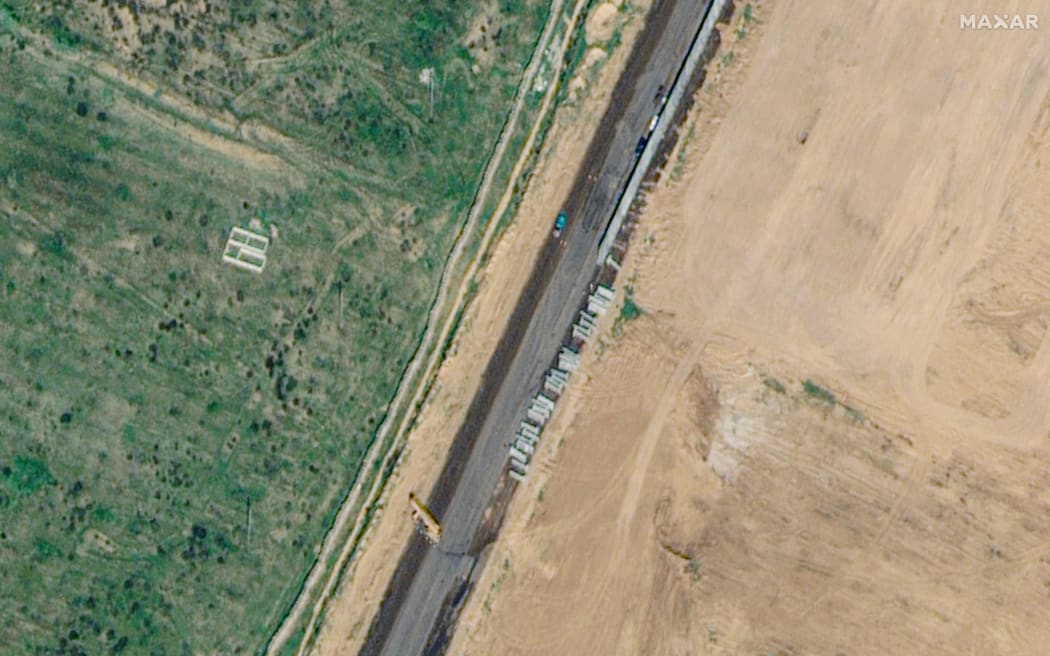
A handout satellite picture taken and released by Maxar Technologies on 15 February, 2024 shows machinery building a wall along the Egypt-Gaza Strip border in Rafah, Egypt. Photo: Handout / Satellite image ©2024 Maxar Technologies / AFP
In addition to the satellite images, photos and videos of the area captured and published by members of the Sinai Foundation for Human Rights also appear to show construction work taking place.
The group said in a report earlier this week that the footage - which has not been verified by the BBC - shows an enclosure featuring seven-metre-high walls being constructed in the area.
The report also quoted a source with knowledge of the matter saying that construction is being carried out with the aim of "receiving refugees from Gaza in the event of a mass exodus of residents of the Strip".
The Wall Street Journal confirmed the report with Egyptian officials and security analysts, stating that the enclosure being constructed is 8 sq miles (20.7 sq km) and could accommodate more than 100,000 people.
Speaking to foreign reporters on Thursday, Israel's Defence Minister Yoav Gallant was emphatic about the matter: "The State of Israel has no intention of evacuating Palestinian civilians to Egypt.
"We respect and value our peace agreement with Egypt, which is a cornerstone of stability in the region as well as an important partner."
Israel knows that it cannot afford to be seen to be driving Palestinians out of their land, but that does not mean it will prevent people from leaving if they want to.
Israel would not stand in the way if Egypt was willing to take some 100,000 refugees (as some estimates of the capacity of the enclosure being built in Egypt's Sinai suggest).
UN officials are deeply apprehensive, fearing that a mass evacuation may be looming. "It looks like it's heading that way," one official told the BBC on condition of anonymity.
Speaking to Reuters news agency at the Munich Security Conference, the UN's High Commissioner for Refugees Filippo Grandi warned that a spill-over of refugees from Rafah into Egypt would be "a disaster for the Palestinians... a disaster for Egypt and a disaster for the future of peace".
Expulsion into Egypt - which is how any evacuation across the border will feel - touches on the deepest Palestinian fears.
Around 80 percent of the Gaza Strip's population are descended from refugees who fled or were driven from their villages during Israel's War of Independence.
To leave Gaza, the last fragment of their ancestral home, would feel to many like a repeat of what Palestinians call the "Naqba", or catastrophe of 1948.
Even if a refugee camp just across the border is described as a temporary shelter, the sense of shock that would accompany their departure from Gaza is likely to be profound.
And while Israel might want to portray this as a voluntary move - a response to an Egyptian invitation - Palestinians would struggle to see it as anything other than another forced expulsion, after more than four months of Israel's assault on the Gaza Strip.
The health ministry in the Hamas-run Palestinian territory reports that at least 28,775 people, mostly women and children, have been killed as a result of Israel's offensive in Gaza.
Israel took action after Hamas-led gunmen killed about 1200 people and seized 253 hostages in a surprise attack on its territory on 7 October.
- This story was first published by BBC
